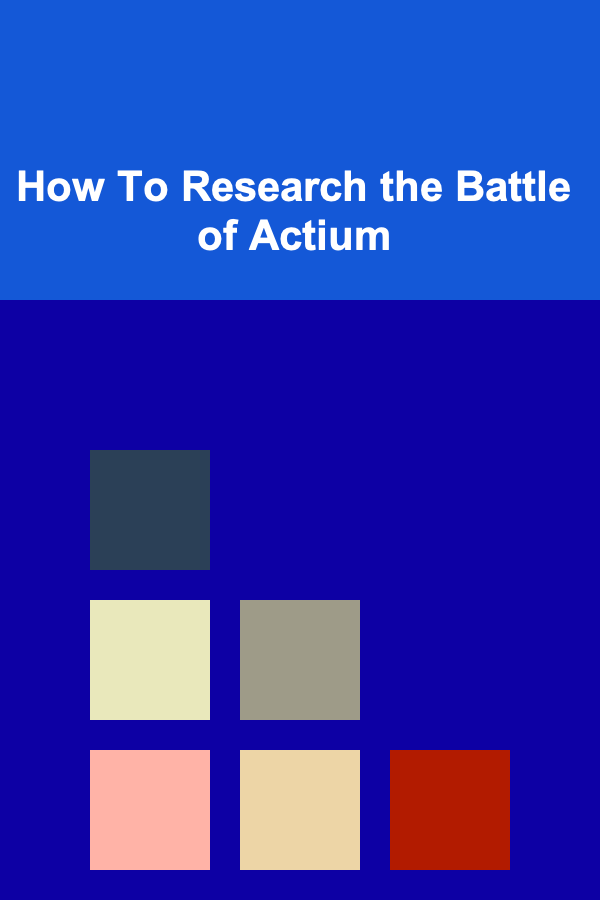
How To Research the Battle of Actium
ebook include PDF & Audio bundle (Micro Guide)
$12.99$8.99
Limited Time Offer! Order within the next:

The Battle of Actium, fought on September 2, 31 BCE, was a decisive naval confrontation between the forces of Octavian (later Augustus) and those of Mark Antony and Cleopatra. This battle, marking the end of the Roman Republic and the beginning of the Roman Empire, has been one of the most extensively studied historical events due to its significance in shaping the ancient world. To understand the Battle of Actium in depth, a multifaceted approach to research is necessary, which combines an analysis of historical sources, the context of the political environment, the strategic decisions involved, and the impact it had on Rome and the Mediterranean world.
This article offers a comprehensive guide on how to research the Battle of Actium. From finding primary sources and secondary literature to understanding the historical and political context, this research journey requires a deep engagement with historical texts, archaeology, and scholarly analysis.
Understand the Historical Context
The Roman Republic and its Decline
To fully grasp the importance of the Battle of Actium, one must first understand the historical backdrop of the late Roman Republic. This period was marked by internal conflict, political corruption, and military strife. The Roman Republic was collapsing under the weight of power struggles among influential leaders such as Julius Caesar, Pompey, and Crassus, who formed the First Triumvirate. The assassination of Julius Caesar in 44 BCE ignited a series of civil wars, leading to the rise of Octavian (the future Augustus), Mark Antony, and Cleopatra.
The research must start with a solid understanding of the Roman Republic's collapse, examining key events like the rise of the Triumvirs, the subsequent wars between Octavian and Antony, and the role of Cleopatra, the Queen of Egypt, in these power dynamics.
Key Figures in the Battle
The central figures in the Battle of Actium were Octavian, Mark Antony, and Cleopatra. Each played a crucial role not only in the battle itself but in the events that led up to it.
- Octavian: The adopted heir of Julius Caesar, Octavian (later Augustus) was a political genius who maneuvered his way to power through strategic alliances, propaganda, and military victory. Understanding his rise to power, including his rivalry with Antony, provides insight into his ultimate victory at Actium.
- Mark Antony: Once a trusted general of Julius Caesar, Antony became one of the most powerful men in Rome after Caesar's assassination. His decision to ally with Cleopatra and his actions in the east alienated him from many Roman senators, which played a significant role in his defeat.
- Cleopatra: The last Pharaoh of Egypt, Cleopatra was a formidable political figure in her own right. Her alliance with Antony, both politically and romantically, was pivotal in the build-up to the Battle of Actium. Research into Cleopatra's life, her reign, and her relationship with Antony is critical to understanding the Battle's context.
The Political Situation in Rome
The battle itself must be placed within the larger struggle for control over the Roman world. Rome was caught between the continuation of the Republican ideals and the rise of autocratic rule, and the events leading to Actium highlighted the battle between these two ideologies.
Primary Sources
Ancient Accounts
The most important part of researching the Battle of Actium involves consulting primary sources, as these offer direct accounts of the battle and its context. Several ancient authors wrote about the events leading to and following the Battle of Actium:
- Suetonius : His work The Twelve Caesars includes extensive information about Octavian (Augustus), Mark Antony, and the political climate of the time. Suetonius provides a biographical approach, giving insight into the personalities of the key players involved.
- Appian of Alexandria : In his Civil Wars, Appian provides an account of the conflict between Octavian and Antony. His narrative of the final years of the Republic is invaluable for understanding the motivations behind the battle and the wider political context.
- Dio Cassius : Another key historian, Dio Cassius' Roman History gives detailed accounts of the civil wars, including the Battle of Actium. His work is considered one of the most comprehensive sources for the history of the Roman Empire.
- Plutarch : In his Lives, Plutarch offers biographical accounts of Antony, Octavian, and Cleopatra. His focus on character provides insight into the motivations and actions of the main figures involved in the battle.
Archaeological Evidence
Primary sources also include archaeological evidence that provides a more tangible connection to the events surrounding Actium. The discovery of naval wrecks and ancient battlefields helps scholars reconstruct the tactics and technology used during the battle. Key sites include:
- The Actium Archaeological Site: Located on the western coast of Greece, this site offers physical evidence of the battle, including fortifications and naval structures that would have played a role in the battle itself.
- Naval Remains: Excavations in the Mediterranean have uncovered wrecks that may belong to the fleets of Octavian or Antony, providing valuable information about the ships and naval tactics used during the battle.
- Coins and Inscriptions: Coins minted during the period often depict key events and leaders, offering visual representations of the battle. Inscriptions found across the Roman Empire also shed light on the political environment and how the Battle of Actium was portrayed to the Roman public.
Secondary Sources
Scholarly Analysis
Secondary sources play a crucial role in understanding the nuances of the Battle of Actium. Modern scholars have written extensively on the battle, providing critical analysis, interpretations, and alternative viewpoints that help contextualize the events. These sources include:
- Books and Articles : Numerous historians have written books and journal articles that provide detailed analyses of the Battle of Actium. Works such as The Battle of Actium by D. T. Potts and The Fall of the Roman Republic by M. T. Boatwright explore the political, military, and cultural ramifications of the battle.
- Journals : Academic journals such as The Journal of Roman Studies and The American Journal of Archaeology frequently publish articles on specific aspects of the Battle of Actium, including the naval tactics, the role of propaganda, and the aftermath of the battle.
- Biographies: Detailed biographies of key figures like Octavian, Mark Antony, and Cleopatra provide deep insight into their motivations, actions, and the political landscape leading up to Actium. These biographies often examine their strategies, leadership styles, and relationships.
Military Strategy and Naval Tactics
The Battle of Actium was a naval engagement, so understanding the naval tactics used is vital to any research. Research into the types of ships used, naval formations, and strategies employed by both Octavian and Antony can be found in military history books and articles. Some of the key areas to explore include:
- Ship Types: The battle involved a mixture of warships, including the large quinqueremes, which were heavily armed ships. The ships' designs, weaponry, and capabilities played a significant role in the outcome of the battle.
- Naval Strategy: Research into the naval tactics of the time, including how fleets were organized and how the forces attempted to outmaneuver one another, will help to understand the military dimensions of the battle.
- Psychological Warfare and Propaganda: Both Octavian and Antony used propaganda to sway public opinion. Research into the role of propaganda, such as Octavian's portrayal of Antony as a traitor and Cleopatra as a foreign seductress, will reveal how the battle was not just a military confrontation but also a political and ideological struggle.
Understanding the Aftermath
The aftermath of the Battle of Actium had far-reaching consequences for both the Roman world and the Mediterranean region.
Octavian's Rise to Power
The Battle of Actium allowed Octavian to consolidate his power, marking the beginning of the Roman Empire and the end of the Roman Republic. Understanding how Octavian presented himself as the savior of Rome and used the battle's victory to solidify his rule as Augustus is essential to researching the historical implications of the battle.
The Fate of Antony and Cleopatra
The defeat of Antony and Cleopatra led to their suicides and the annexation of Egypt by Rome. The political, cultural, and economic consequences of this are significant and should be researched in relation to the power dynamics of the Mediterranean world.
The Roman Empire
The Battle of Actium marked the beginning of a new era in Roman history, where Augustus became the first emperor. Research into how the battle and its aftermath shaped the future of the Roman Empire provides insight into the profound shifts that occurred in politics, governance, and the relationship between the emperor and the people.
Conclusion
Researching the Battle of Actium requires a multidimensional approach, combining ancient texts, archaeological evidence, and modern scholarship. Understanding the battle in its political, military, and cultural context will allow you to grasp not only its immediate significance but also its profound impact on the trajectory of Roman history. By studying the primary sources, analyzing secondary literature, and delving into the wider implications of the battle, you can gain a deep understanding of this pivotal event and its lasting legacy on the ancient world.

How to Incorporate Smart Storage in Your Home Renovation
Read More
How to Start Investing in Real Estate with No Experience
Read More
The Future of Passive Income: How Deep Learning Can Help
Read More
Why Creating a Homework Station Boosts Kids' Productivity
Read More
How to Master Wilderness First Aid (Advanced)
Read More
How to Set Realistic Weight Loss Goals: A Comprehensive Guide
Read MoreOther Products

How to Incorporate Smart Storage in Your Home Renovation
Read More
How to Start Investing in Real Estate with No Experience
Read More
The Future of Passive Income: How Deep Learning Can Help
Read More
Why Creating a Homework Station Boosts Kids' Productivity
Read More
How to Master Wilderness First Aid (Advanced)
Read More